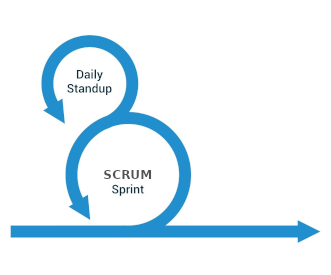Daily Standup uniting developer experiences
SCRUM is a widely-used agile software development methodology that emphasizes teamwork, collaboration, and transparency. At the core of Scrum are two key procedures: daily stand-ups and shorter sprint cycles. These procedures help to ensure that the development team is aligned, focused, and delivering high-quality software in a timely and efficient manner.
The daily stand-up is a short, daily meeting where team members share updates on their progress and any blockers or challenges they are facing. This helps to ensure that everyone is on the same page and that any issues can be identified and addressed quickly. The short, time-boxed nature of the daily stand-up keeps the meeting focused and efficient, and helps to ensure that everyone is aligned and working together towards a common goal.
Shorter sprint cycles are another key component of SCRUM. Rather than working on a project for months or even years, Scrum teams work in short, time-boxed sprints of typically one to four weeks. This allows the team to deliver small, usable increments of software on a regular basis, and to get feedback from stakeholders and customers. The shorter sprint cycles also help to ensure that the team remains focused, and that any issues are identified and addressed quickly.
The combination of daily stand-ups and shorter sprint cycles leads to several benefits, including:
-
More transparent communication: By having daily stand-ups and shorter sprint cycles, the development team is able to communicate more effectively and transparently, which helps to ensure that everyone is on the same page and working towards a common goal.
-
Faster feedback loops: With shorter sprint cycles and more transparent communication, the development team is able to receive feedback from stakeholders and customers more quickly. This helps to ensure that the software being developed meets the needs of all stakeholders, and that any issues are identified and addressed early in the development process.
-
Improved alignment: The daily stand-up and shorter sprint cycles help to ensure that the development team is aligned and focused, which leads to better collaboration and teamwork, and to higher-quality software being delivered.
-
Increased efficiency: The shorter sprint cycles and more transparent communication help to increase the efficiency of the development team, as they are able to identify and address issues more quickly and are able to deliver software faster and with higher quality.
In conclusion, the SCRUM procedures of daily stand-ups and shorter sprint cycles are key to the success of agile software development projects. These procedures help to ensure that the development team is aligned, focused, and delivering high-quality software in a timely and efficient manner. By investing in Scrum, you can be confident that your software project will be successful, and that your stakeholders and customers will be satisfied with the end result.

 EN
EN  DE
DE  FR
FR  ES
ES  IT
IT 